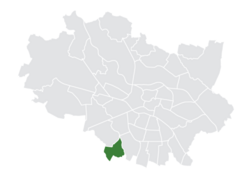Klecina (Polish pronunciation: [klɛˈt͡ɕina], German: Klettendorf, [ˈklɛtəndɔɐ̯f]) is a district in Wrocław, Poland, located in the southern part of the city. It was established in the territory of the former Krzyki district.
Klecina | |
|---|---|
 Virgin Mary Queen of Poland church | |
 Location of Klecina within Wrocław | |
| Country | |
| Voivodeship | Lower Silesian |
| County/City | Wrocław |
| Incorporated into the city | 1951 |
| Established the modern-day district | 1991 |
| Population (2022) | |
• Total | 7,647 |
| [1] | |
| Time zone | UTC+1 (CET) |
| • Summer (DST) | UTC+2 (CEST) |
| Area code | +48 71 |
| Website | klecina.wroclaw.pl |
Initially a village, the settlement was incorporated into Wrocław in 1951.[2]
History
editThe village was first mentioned in 1313, under the name of Clettindorf. This is believed to be the first written record of the name, in a document describing a historic trade transaction.[3]
In 1835, the first sugar factory in the Breslau area was established in Klettendorf. The development of the entire village of Klettendorf was significantly influenced by the sugar factory. It provided jobs for the residents, which led to the growth of the village. In 1845, Klettendorf had a population of 441 people, and by 1910, the population had increased to about 2,500.[2] The sugar factory owners constructed housing, a health clinic, and a sewage system for their workers. Additionally, a retirement home was built in Koberwitz to assist retirees.[3]
After the surrender of Breslau in May 1945, the sugar factory served as a prison for German soldiers. Additionally, it became the largest warehouse for the spoils of war that the Russians brought from looted Breslau. The warehouse contained everything from furniture to instruments and typewriters. The spoils were then transported to the USSR. The hangar and grass runway in Klecina were also used by Soviet troops to repair aircraft parts. In 1946, the rest of the German population in Klecina left their homes.[3][4]
The citizens of Klettendorf opposed the idea of incorporating their town into Breslau due to the potential increase in taxes and the risk of losing their lands where they grew beets for production. They were successful in maintaining Klettendorf's independence until 1945 when Wrocław (Breslau) became a part of Poland. In 1951, Klecina was incorporated into Wrocław by the Polish administration.[3]
In 1946, the sugar factory in Klecina resumed production. The neighborhood had a negative reputation for years, and the fumes emanating from the factory did not attract residents to the area. The neighborhood was primarily occupied by sugar factory workers from all over Poland for only a few months each year during the beet campaign period when labor was required to harvest the beets. Individuals from outside of Wrocław did not feel a connection to the area.[3]
In 1991, after reforms in the administrative division of Wrocław, Klecina became one of the city's 48 districts.[5] Until 1991, Soviet Army troops were stationed in Klecina.[4]
The factory eventually closed in 1997 and the complex was demolished in 1999.[3]
References
edit- ^ "Liczba mieszkańców zameldowanych we Wrocławiu w podziale na Osiedla – stan na 31 grudnia 2022 r."
- ^ a b "Klecina – historia cukrowego osiedla".
- ^ a b c d e f "Historia. 700 lat Kleciny, czyli słodko-gorzkie losy małej wsi".
- ^ a b "Klecina". Bezpartyjny Wrocław (in Polish). Retrieved 2024-01-03.
- ^ "UCHWAŁA NR XX/110/91 RADY MIEJSKIEJ WROCŁAWIA z dnia 20 marca 1991 roku w sprawie podziału Wrocławia na osiedla".